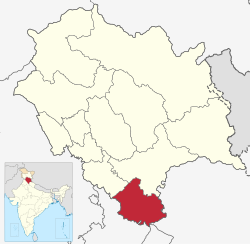|
Sirmaur district
Sirmaur district is the southernmost district of Himachal Pradesh, northern India. It is largely mountainous and rural, with 90% of its population living in villages. Some of its towns include the capital Nahan, Paonta Sahib, Lana palar, Tuheri, Bhawan, Sirmaur, Shamra, UchaTikker and Suketi, the latter known for Shivalik Fossil Park. GeographyThere are seven tehsils in this district: Nahan, Renuka, Kamrau, Shillai, Rajgarh, Pachhad, and Paonta Sahib. The Giri River divides the district into two almost equal parts: Giripar and Giriaar. The major towns are Nahan, Paonta Sahib, Rajgarh, and Shillai. Rajgarh is the biggest village of Sirmour district. History
DemographicsAccording to the 2011 Census of India, Sirmaur district has a population of 529,855, which placed it 542nd in India (out of a total of 640).[2] The district had a population density of 188 inhabitants per square kilometre (490/sq mi).[2] Its population growth rate over the decade 2001–2011 was 15.61%.[2] Sirmaur had a sex ratio of 915 females for every 1000 males,[2] and a literacy rate of 79.98%. 10.79% of the population lived in urban areas. Scheduled Castes and Scheduled Tribes made up 30.34% and 2.13% of the population respectively.[2] LanguageAs of the 2011 census, 39% of the population of the district identified their first language as Hindi, 34% as Pahari, and 20% as Sirmauri. There were also speakers of Punjabi (3.88%), Nepali (0.94%), Haryanvi, (0.43%), and Tibetan (0.42%).[4] Declared a national park in 2010, Simbalbara National Park is located in Sirmaur district. It covers an area of around 27.88 sq.km. The fauna of Simbalbara National Park includes, Goral, Spotted Deer, Sambhar, Himalayan Black Bear, Hanuman Langurs and Indian Muntjacs. The flora includes Sal forests and lush green pastures. Politics
See alsoNotable peopleReferences
External links |
|||||||||||||||||||||||||||||||||||||||||||||||||||||||||||||||||||||||||||||||||||||||||||||||||||||||||||||||||||||||||||||||||||||






